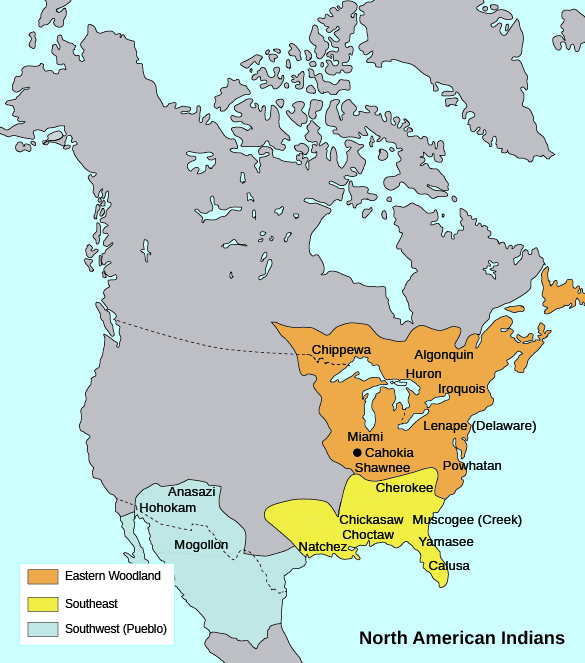| << Chapter < Page | Chapter >> Page > |
Encouraged by the wealth found by the Spanish in the settled civilizations to the south, fifteenth- and sixteenth-century English, Dutch, and French explorers expected to discover the same in North America. What they found instead were small, disparate communities, many already ravaged by European diseases brought by the Spanish and transmitted among the natives. Rather than gold and silver, there was an abundance of land, and the timber and fur that land could produce.
The Indians living east of the Mississippi did not construct the large and complex societies of those to the west. Because they lived in small autonomous clans or tribal units, each group adapted to the specific environment in which it lived ( [link] ). These groups were by no means unified, and warfare among tribes was common as they sought to increase their hunting and fishing areas. Still, these tribes shared some common traits. A chief or group of tribal elders made decisions, and although the chief was male, usually the women selected and counseled him. Gender roles were not as fixed as they were in the patriarchal societies of Europe, Mesoamerica, and South America.

Women typically cultivated corn, beans, and squash and harvested nuts and berries, while men hunted, fished, and provided protection. But both took responsibility for raising children, and most major Indian societies in the east were matriarchal. In tribes such as the Iroquois, Lenape, Muscogee, and Cherokee, women had both power and influence. They counseled the chief and passed on the traditions of the tribe. This matriarchy changed dramatically with the coming of the Europeans, who introduced, sometimes forcibly, their own customs and traditions to the natives.
Clashing beliefs about land ownership and use of the environment would be the greatest area of conflict with Europeans. Although tribes often claimed the right to certain hunting grounds—usually identified by some geographical landmark—Indians did not practice, or in general even have the concept of, private ownership of land. There were tribal hunting grounds, usually identified by some geographical landmark, but there was no private ownership of land. A person’s possessions included only what he or she had made, such as tools or weapons. The European Christian worldview, on the other hand, viewed land as the source of wealth. According to the Christian Bible, God created humanity in his own image with the command to use and subdue the rest of creation, which included not only land, but also all animal life. Upon their arrival in North America, Europeans found no fences, no signs designating ownership. Land, and the game that populated it, they believed, were there for the taking.
Great civilizations had risen and fallen in the Americas before the arrival of the Europeans. In North America, the complex Pueblo societies including the Mogollon, Hohokam, and Anasazi as well as the city at Cahokia had peaked and were largely memories. The Eastern Woodland peoples were thriving, but they were soon overwhelmed as the number of English, French, and Dutch settlers increased.
Mesoamerica and South America had also witnessed the rise and fall of cultures. The once-mighty Mayan population centers were largely empty. In 1492, however, the Aztecs in Mexico City were at their peak. Subjugating surrounding tribes and requiring tribute of both humans for sacrifice and goods for consumption, the island city of Tenochtitlán was the hub of an ever-widening commercial center and the equal of any large European city until Cortés destroyed it. Further south in Peru, the Inca linked one of the largest empires in history through the use of roads and disciplined armies. Without the use of the wheel, they cut and fashioned stone to build Machu Picchu high in the Andes before abandoning the city for unknown reasons. Thus, depending on what part of the New World they explored, the Europeans encountered peoples that diverged widely in their cultures, traditions, and numbers.

Notification Switch
Would you like to follow the 'U.s. history' conversation and receive update notifications?